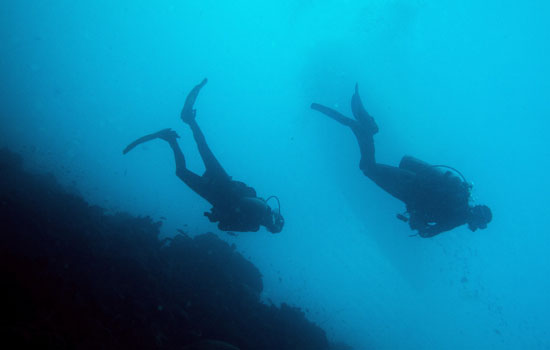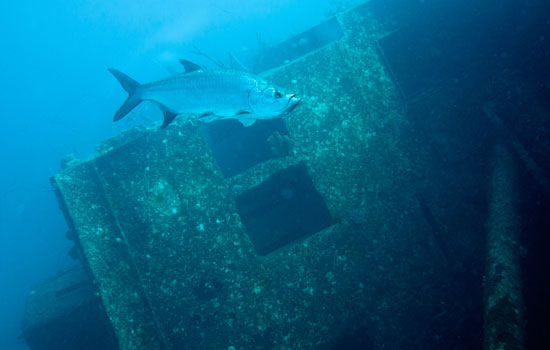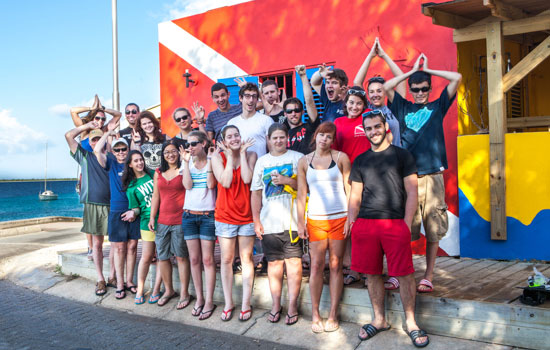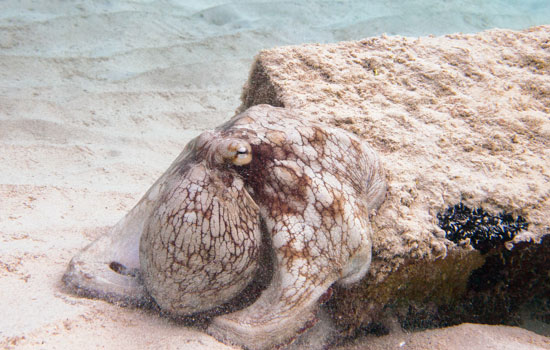Students immersed in underwater photography
RIT students use underwater photography and videography during study-abroad trip to Bonaire
Tim Tiebout
The advanced underwater imaging class traveled to Bonaire in December. At one point, a group of students spent approximately 20 minutes with an octopus.
College courses can be a demanding experience for even the most well-prepared students—and those are the courses that are held in a classroom on dry land. Now imagine that your course is held more than 100 feet below the surface of the ocean.
In December, a group of students and faculty from Rochester Institute of Technology traveled to the South Caribbean island of Bonaire, known for its accessibility to divers and its incredibly diverse marine life, for an annual study-abroad course in advanced underwater imaging.
The seven-day trip was an opportunity for the students to learn about diving and underwater photography and videography. The students performed a variety of dives and techniques, including night, deep and wreck dives, and as a result, many of them earned advanced diver certifications. Rene Piccarreto, an adjunct professor at RIT, says that the opportunity to learn advanced diving techniques and photography skills simultaneously is a unique one.
“There’s a steep learning curve, but by about the middle of the trip, everything comes together,” says Piccarreto, who leads the course. “The students’ diving abilities quickly get to a point where they can fully integrate their photo and film skills into the dives.”
This was the fourth time Piccarreto has led the course, and it has grown in size and scope with each subsequent year. Twenty-two people went on the most recent trip, including 12 new divers and seven who had gone in previous years.
New this year, the students created a website with an interactive PDF that contains a series of articles, photos and a video documenting various aspects of Bonaire and diving. Additionally, a blog was set up through the website for students to document their experiences.
Mike Norman, a fourth-year information technology major, was one of a growing number of students from programs outside of the College of Imaging Arts and Sciences to take the course. Norman created the website and assisted with many technical aspects that have helped to add a more technology-based dimension to the course.
“I think it’s great to include people with different skill sets,” says Norman. “Taking a course outside of your major and your comfort zone really opens your mind.”
The course has gotten students hooked on diving. Piccarreto notes that some of the students from past years have gone on to become dive masters and instructors. “Of course there have always been talented photographers, but there are also some really talented divers at RIT. It’s kind of a hidden community,” he says.
Nicholas Mancuso, a fourth-year biomedical photographic communications major; Timothy Tiebout, a biomedical photographic communications major who graduated in February; and Myles Crawford, a third-year film and animation major, all contributed extensively to the creation of the PDF and video. The video will be entered in RIT’s School of Film and Animation Honor Show.
The trip also afforded the group many opportunities to interact with an abundance of marine animals, including octopuses, eels, turtles and lionfish, among many others. At one point, a group of students spent approximately 20 minutes with an octopus. “It was incredible the way it blended in with its environment. You could barely discern it from a rock,” Mancuso recalls.
Despite the thriving aquatic life of Bonaire, debris pollution is a major environmental issue on the island. On previous trips, the group has focused on issues such as underwater pollution and the overpopulation of lionfish. This year, the group spent time helping to clean the coasts by collecting garbage to fill large mesh bags provided by Dive Friends Bonaire.
Piccarreto is planning to return to Bonaire next winter, and many of the students have eagerly expressed interest in going back. Nearly every student had something positive to say about the experience.
“It is one of the best things I’ve ever done,” says Mancuso.
 The advanced underwater imaging class traveled to Bonaire in December. Nick Neumann
The advanced underwater imaging class traveled to Bonaire in December. Nick Neumann The advanced underwater imaging class, led by RIT adjunct professor Rene Piccarreto, traveled to Bonaire in December. Timothy Tiebout, a biomedical photographic communications major who graduated in February, took this shot. Tim Tiebout
The advanced underwater imaging class, led by RIT adjunct professor Rene Piccarreto, traveled to Bonaire in December. Timothy Tiebout, a biomedical photographic communications major who graduated in February, took this shot. Tim Tiebout The advanced underwater imaging class, led by RIT adjunct professor Rene Piccarreto, traveled to Bonaire in December. The seven-day trip was an opportunity for the students to learn about diving and underwater photography and videography. Amy Stafford
The advanced underwater imaging class, led by RIT adjunct professor Rene Piccarreto, traveled to Bonaire in December. The seven-day trip was an opportunity for the students to learn about diving and underwater photography and videography. Amy Stafford













